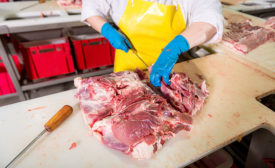Special Reports
The perennial sandwich favorite is experimenting with meaty, upscale and indulgent versions.
Read More
2017 Food Safety Report
Designed to shine?: Sanitary design and construction
Facilities and equipment should be built or bought with sanitation and food safety at the top of the priority list.
Read More
2017 Food Safety Report
Foodborne illness estimates: Fascinating and misleading
Comparing CDC’s estimated numbers to reality when it comes to annual foodborne illness predictions.
Read More
2017 Food Safety Report
Food safety apparel: Wear it well
Requiring workers to wear sanitized apparel while guarding the garments from contaminants is crucial for enhancing food safety in meat and poultry plants.
Read More
Meat Science Review
Determining quality of steak: The human brain doesn’t lie
Novel MRI technique could revolutionize how meat product sensory evaluation is performed.
Read More
Special Report
2017 Seafood Report: Riding the wave
Seafood consumption is up as consumers reinvent old classics.
Read More
Business Strategies
How will the Trump presidency affect the meat industry
America's new CEO? What the Donald Trump presidency may mean for the meat, poultry and agriculture industries in 2017.
Read More
Special Report
2017 Poultry Report: Fixing 'flat'
Poultry products remain popular with consumers and the industry has plenty of open road ahead; but external mitigating factors continued to tamp down sales in 2016 and have some areas in need of a tuneup.
Read More
Business Strategies
Influence of Gen Z grows
Young people look to foodservice to satisfy cravings,
offer unique items.
Read More
Stay ahead of the curve. Unlock a dose of cutting-edge insights.
Receive our premium content directly to your inbox.
SIGN-UP TODAYCopyright ©2024. All Rights Reserved BNP Media.
Design, CMS, Hosting & Web Development :: ePublishing














